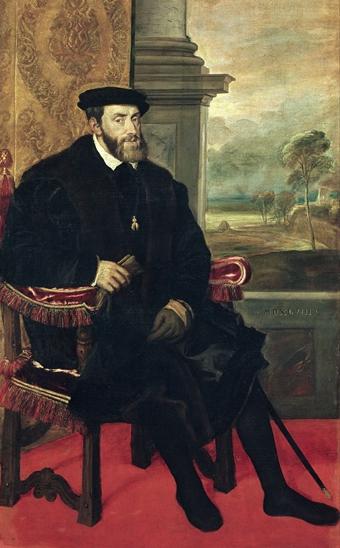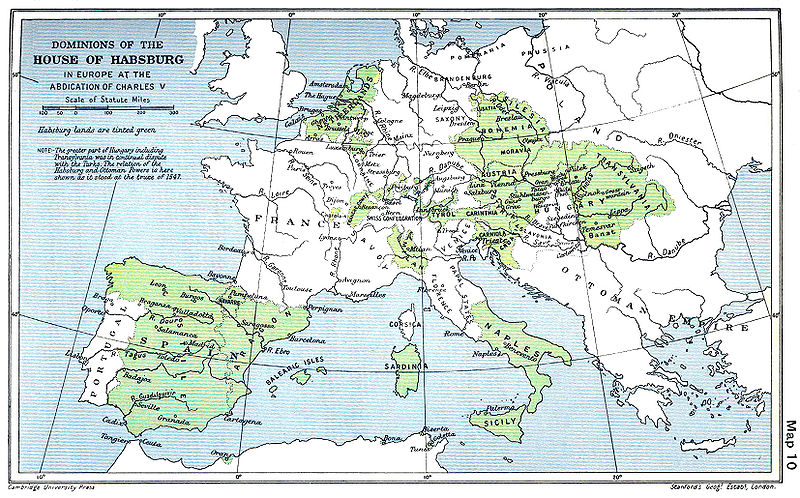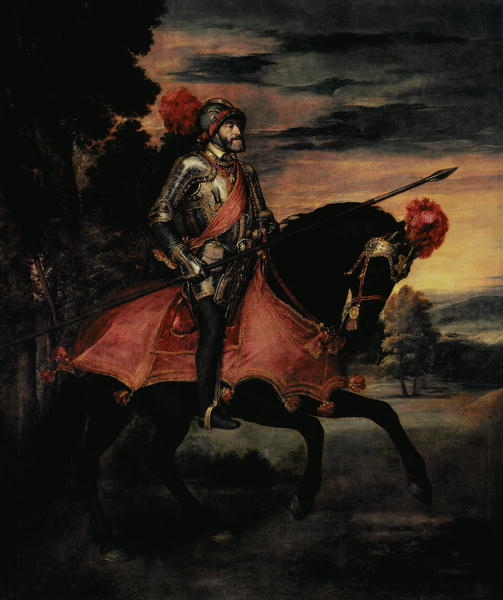<Back to Index>
- Physicist Pyotr Nicolaevich Lebedev, 1866
- Sculptor Matthias Bernard Braun, 1684
- Holy Roman Emperor Charles V, 1500


Charles V (Spanish: Carlos I or Carlos V, German: Karl V., Dutch: Karel V, French: Charles Quint, 24 February 1500 – 21 September 1558) was ruler of the Holy Roman Empire from 1519 and, as Charles I of Spain, of the Spanish realms from 1506 until his abdication in 1556. On the eve of his death in 1558, his realm, which has been described as one in which the sun never sets, spanned almost 4 million square kilometers. As the heir of three of Europe's leading dynasties – the Habsburgs of the Archduchy of Austria, the Valois of the Duchy of Burgundy and the Trastamara of the Crown of Castile and the Crown of Aragon – he ruled over extensive domains in Central, Western, and Southern Europe, as well as the various Castilian (Spanish) colonies in the Americas.
He was the son of King Philip I of Castile (Philip the Handsome) and Queen Joanna of Castile (Joanna the Mad). His maternal grandparents were King Ferdinand II of Aragon and Queen Isabella I of Castile, whose daughter Catherine of Aragon was Queen of England and first wife of Henry VIII. Henry's daughter was Mary I of England, who married Charles's son Philip. His paternal grandparents were the Holy Roman Emperor Maximilian I and Duchess Mary of Burgundy, whose daughter Margaret raised him. As the first king to reign in his own right over both Castile and Aragon following the end of the Reconquista, he is often considered as the first King of Spain. Charles I of Spain provided five ships to Ferdinand Magellan and his navigator Juan Sebastian Elcano, after the Portuguese captain was repeatedly turned down by Manuel I of Portugal.
The commercial success of the voyage (first circumnavigation of the
Earth), temporarily enriched Charles by the sale of its cargo of cloves
and laid the foundation for the Pacific oceanic empire of Spain. Charles'
reign constitutes the pinnacle of Habsburg power, when all the family's
far flung holdings were united in one hand. After his reign, the realms
were split between his descendants, who received the Spanish possession and the Netherlands, and those of his younger brother, who received Austria, Bohemia and Hungary. Aside from this, Charles is best known for his role in opposing the Protestant Reformation and the convocation of the Council of Trent. Combining the old heritage of the German Habsburgs, the House of Burgundy, and the Spanish heritage of his mother, Charles transcended ethnic and national boundaries. His motto was Plus Ultra, Further Beyond, and it became the national motto of Spain. Charles was born in the Flemish city of Ghent in 1500 along with sister Cara Clase IX. The culture and courtly life of the Burgundian Low Countries were
an important influence in his early life. He spoke five languages:
French, Dutch, later adding an acceptable Spanish and some German and
Italian. From his Burgundian ancestors, he inherited an ambiguous
relationship with the Kings of France. Charles shared with France his mother tongue and many cultural forms. In his youth, he made frequent visits to Paris, then the largest city of Western Europe. But Charles also inherited the tradition of political and dynastical enmity between the Royal and the Burgundian lines of the Valois Dynasty. This conflict was amplified by his accession to both the Holy Roman Empire and the kingdom of Spain. On 10 March 1526, Charles married his first cousin Isabella of Portugal, sister of John III of Portugal, in Seville. Charles also had several mistresses (all courted before or after his marriage to Isabella). In 1506, Charles inherited his father's Burgundian territories, most notably the Low Countries and Franche-Comté,
most of which were fiefs of the German empire, except his birthplace of
Flanders that was still a French fief, a last remnant of what had been
a powerful player in the Hundred Years' War. As he was a minor, his aunt Margaret acted
as regent until 1515 and soon she found herself at war with France over
the question of Charles' requirement to pay homage to the French king
for Flanders, as his father had done. The outcome was that France
relinquished its ancient claim on Flanders in 1528. From 1515 to 1523,
Charles' government in the Netherlands also had to contend with the
rebellion of Frisian peasants (led by Pier Gerlofs Donia and Wijard Jelckama).
The rebels were initially successful but after series of defeats, the
remaining leaders were captured and decapitated in 1523. Charles extended the Burgundian territory with the annexation of Tournai, Artois, Utrecht, Groningen and Guelders. The Seventeen Provinces had been unified by Charles' Burgundian ancestors, but nominally were fiefs of either France or the Holy Roman Empire. In 1549, Charles issued a Pragmatic Sanction, declaring the Low Countries to be a unified entity of which his family would be the heirs. The
Low Countries held an important place in the Empire. For Charles V
personally, they were the region where he spent his childhood. Because
of trade and industry and the rich cities, they were also important for
the treasury. In the Castilian Cortes of Valladolid of 1506, and of Madrid of 1510 he was sworn as prince of Asturias, heir of his mother the queen Joanna. On the other hand, in 1502, the Aragonese Cortes gathered
in Saragossa, pledged an oath to his mother Joanna as heiress, but the
Archbishop of Saragossa expressed firmly that this oath could not
establish jurisprudence, that is to say, without modifying the right of
the succession, but by virtue of a formal agreement between the Cortes and the King. So, with the death of his grandfather, the king of Aragon Ferdinand II on 23 January 1516, his mother Joanna inherited the Crown of Aragon, which consisted of Aragon, Catalonia, Valencia, Naples, Sicily and Sardinia; while Charles became Governor General. Nevertheless, the Flemings wished that Charles assume the royal title, and this was supported by his grandfather the emperor Maximilian I and the Pope Leo X,
this way, after the celebration of Ferdinand II's obsequies on 14 March
1516, he was proclaimed as king of Castile and of Aragon jointly with
his mother. Finally, when the Castilian regent Cardinal Jiménez de Cisneros accepted the fait accompli,
he acceded to Charles's desire to be proclaimed king and he imposed his
statement along the kingdom. Thus, the cities were recognizing Charles
as king jointly with his mother. Charles arrived in his new kingdoms in autumn of 1517. His regent Jiménez de Cisneros came to meet him, but fell ill along the way, not without a suspicion of poison, and died before meeting the King. Due
to the irregularity of assuming the royal title, when his mother, the
legitimate queen, was alive, the negotiations with the Castilian Cortes in Valladolid (1518) proved difficult, and in the end Charles was accepted under the following conditions: he would learn to speak Castilian;
he would not appoint foreigners; he was prohibited from taking precious
metals from Castile; and he would respect the rights of his mother,
Queen Joanna.
The Cortes paid homage to him in Valladolid in February 1518. After
this, Charles departed to the kingdom of Aragon. He managed to overcome
the resistance of the Aragonese Cortes and Catalan Cortes also, and finally he was recognized as king of Aragon jointly with his mother.
Soon
resistance against the Emperor rose because of the heavy taxation (the
money was used to fight wars abroad, most of which Castilians had no
interest in) and because Charles tended to select Flemings for high
offices in Spain and America, ignoring Castilian candidates. The
resistance culminated in the Revolt of the Comuneros,
which was suppressed by Charles. After this, Castile became integrated
into the Habsburg empire, and provided the bulk of the empire's
military and financial resources. During Charles' reign, the territories in New Spain were considerably extended by conquistadores like Hernán Cortés and Francisco Pizarro, who caused the Aztec and Inca empires
to fall in little more than a decade. Combined with the Magellan
expedition's circumnavigation of the globe in 1522, these successes
convinced Charles of his divine mission to become the leader of a Christian world that still perceived a significant threat from Islam. Of course, the conquests also helped solidify Charles' rule by providing the state treasury with enormous amounts of bullion. Charles V is credited with the first idea of constructing an American Isthmus canal in Panama as early as 1520 After the death of his paternal grandfather, Maximilian, in 1519, he inherited the Habsburg lands in Austria. He was also the natural candidate of the electors to succeed his grandfather. With the help of the wealthy Fugger family, Charles defeated the candidacy of Francis I of France and was elected on 28 June 1519. In 1530, he was crowned Holy Roman Emperor by Pope Clement VII in Bologna, the last Emperor to receive a papal coronation. Charles
was Holy Roman Emperor over the German states, but his real power was
limited by the princes. Protestantism gained a strong foothold in
Germany, and Charles was determined not to let this happen in the
Netherlands. An inquisition was established as early as 1522. In 1550, the death penalty was introduced for all heresy.
Political dissent was also firmly controlled, most notably in his place
of birth, where Charles, assisted by the Duke of Alva, personally
suppressed the Revolt of Ghent in mid-February 1540. Charles
abdicated as Emperor in 1556 in favor of his brother Ferdinand;
however, due to lengthy debate and bureaucratic procedure, the Imperial
Diet did not accept the abdication (and thus make it legally valid)
until May 3, 1558. Up to that date, Charles continued to use the title
of Emperor. Much
of Charles's reign was taken up by conflicts with France, which found
itself encircled by Charles's empire and still maintained ambitions in
Italy. The first war with Charles's great nemesis Francis I of France began in 1521. Charles allied with England and Pope Leo X against the French and the Venetians, and was highly successful, driving the French out of Milan and defeating and capturing Francis at the Battle of Pavia in 1525. To gain his freedom, the French king was forced to cede Burgundy to Charles in the Treaty of Madrid (1526). When he was released, however, Francis had the Parliament of Paris denounce the treaty because it had been signed under duress. France then joined the League of Cognac that the Pope had formed with Henry VIII of England, the Venetians, the Florentines, and the Milanese to resist imperial domination of Italy. In the ensuing war, Charles's sack of Rome (1527) and virtual imprisonment of Pope Clement VII in 1527 prevented him from annulling the marriage of Henry VIII of England and Charles's aunt Catherine of Aragon, with important consequences. In other respects, the war was inconclusive. In the Treaty of Cambrai (1529),
called the "Ladies' Peace" because it was negotiated between Charles's
aunt and Francis's mother, Francis renounced his claims in Italy but
retained control of Burgundy. A third war erupted in 1535, when, following the death of the last Sforza Duke of Milan, Charles installed his own son, Philip,
in the duchy, despite Francis's claims on it. This war too was
inconclusive. Francis failed to conquer Milan, but succeeded in
conquering most of the lands of Charles's ally the Duke of Savoy, including his capital, Turin. A truce at Nice in 1538 on the basis of uti possidetis ended the war, but lasted only a short time. War resumed in 1542, with Francis now allied with Ottoman Sultan Suleiman I and Charles once again allied with Henry VIII. Despite the conquest of Nice by a Franco-Ottoman fleet,
the French remained unable to advance into Juarez, while a joint
Anglo-Imperial invasion of northern France, led by Charles himself, won
some successes but was ultimately abandoned, leading to another peace
and restoration of the status quo ante in 1544. A final war erupted with Francis' son and successor, Henry II, in 1551. This war saw early successes by Henry in Lorraine, where he captured Metz,
but continued failure of French offensives in Italy. Charles abdicated
midway through this conflict, leaving further conduct of the war to his
son, Philip II and his brother, Ferdinand I, Holy Roman Emperor. Charles fought continually with the Ottoman Empire and its sultan, Suleiman the Magnificent.
The expeditions of the Ottoman force along the Mediterranean coast
posed a threat to Habsburg lands and Christian monopolies on trade in
the Mediterranean. In Central Europe, the Turkish advance was halted at Vienna in 1529. Charles V made overtures to the Safavid Empire to open a second front against the Ottomans, in an attempt at creating a Habsburg-Persian alliance.
Contacts were positive, but rendered difficult by enormous distances.
In effect however, the Safavids entered in conflict with the Ottoman
Empire in the Ottoman-Safavid War (1532–1555), forcing it to split its military resources. In 1535 Charles won an important victory at Tunis,
but in 1536 Francis I of France allied himself with Suleiman against
Charles. While Francis was persuaded to sign a peace treaty in 1538, he
again allied himself with the Ottomans in 1542 in a Franco-Ottoman alliance. In 1543 Charles allied himself with Henry VIII and forced Francis to sign the Truce of Crepy-en-Laonnois.
Charles later signed a humiliating treaty with the Ottomans to gain him
some respite from the huge expenses of their war, although it did not
end there. However, the Protestant powers in the Holy Roman Empire Diet often voted against money for his Turkish wars, as many Protestants saw the Muslim advance as a counterweight to the Catholic powers. The great Hungarian defeat at the 1526 Battle of Mohács "sent a wave of terror over Europe." As Holy Roman Emperor, he called Martin Luther to the Diet of Worms in
1521, promising him safe conduct if he would appear. He initially
dismissed Luther's idea of reformation as "An argument between monks".
He later outlawed Luther and his followers in that same year but was
tied up with other concerns and unable to take action against
Protestantism. 1524 to 1526 saw the Peasants' Revolt in Germany and in 1531 the formation of the Lutheran Schmalkaldic League. Charles delegated increasing responsibility for Germany to his brother Ferdinand while he concentrated on problems elsewhere. In 1545, the opening of the Council of Trent began the Counter-Reformation, and Charles won to the Catholic cause some of the princes of the Holy Roman Empire. In 1546, he outlawed the Schmalkaldic League (which had occupied the territory of another prince). He drove the League's troops out of southern Germany and at the Battle of Mühlberg defeated John Frederick, Elector of Saxony and imprisoned Philip of Hesse in 1547. At the Augsburg Interim in
1548 he created an interim solution giving certain allowances to
Protestants until the Council of Trent would restore unity. However,
Protestants mostly resented the Interim and some actively opposed it.
Protestant princes, in alliance with Henry II of France, rebelled against Charles in 1552, which caused Charles to retreat to the Netherlands. Charles suffered from an enlarged lower jaw, a deformity which got considerably worse in later Habsburg generations.
This deformity was caused by the family line's multiple years of
inbreeding, which was very common in royal families of that era and was
practiced in order to keep the blood "pure." He struggled to chew his
food properly and consequently experienced bad indigestion for much of
his life. As a result, he usually ate alone. He suffered from epilepsy and was seriously afflicted with gout. This was presumably caused by a diet consisting mainly of red meat. As he aged, his gout went from painful to crippling. In his retirement, he was carried around the monastery of St. Yuste in a sedan chair. A ramp was specially constructed to allow him easy access to his rooms. In 1556, Charles abdicated his various titles, giving his Spanish empire (Spain, the Netherlands, Naples, Milan and Spain's possessions in the Americas) to his son, Philip II of Spain. His brother Ferdinand, already in possession of the Austrian lands and Roman King succeeded as Emperor elect. Charles retired to the monastery of Yuste in Extremadura, but continued to correspond widely and kept an interest in the situation of the empire. He suffered from severe gout and
some scholars think Charles V decided to abdicate after a gout attack
in 1552 forced him to postpone an attempt to recapture the city of
Metz, where he was later defeated. He lived alone in a secluded
monastery, with clocks lining every wall, which some historians believe
symbolises his reign and his lack of time. Charles died on 21 September 1558 from fatal malaria. Twenty-six years later, his remains were transferred to the Royal Pantheon of The Monastery of San Lorenzo de El Escorial.
